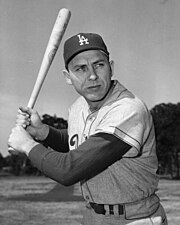Gil Hodges
One of the most beloved and admired players in major league history, Hodges was inducted into the Baseball Hall of Fame in 2022, fifty years after his sudden death.
He grew up in Petersburg, Indiana where he was a four-sport athlete in high school, before attending Saint Joseph's College where he played baseball and basketball.
He dropped out to sign with the Brooklyn Dodgers, making his debut at age 19 before being joining the United States Marine Corps during World War II, receiving the Bronze Star Medal after serving in combat as an anti-aircraft gunner during in the battles of Tinian and Okinawa in the Pacific theatre.
During his time with the Brooklyn Dodgers, Hodges was a core member of the "Boys of Summer", along with Jackie Robinson, Roy Campanella, Duke Snider, and Pee Wee Reese.
He was a star four-sport athlete at Petersburg High School, earning a combined seven varsity letters in football, baseball, basketball and track.
Hodges declined a 1941 contract offer from the Detroit Tigers, instead attending Saint Joseph's College with the hope of eventually becoming a collegiate coach.
He dropped out after his sophomore year, accepting a contract from Stanley Feezle, a sporting goods storeowner and part-time scout, to sign with the Brooklyn Dodgers.
[3] Following the war, Hodges also spent time completing course work at Oakland City University, near his hometown, playing basketball for the Mighty Oaks, joining the 1947–48 team after four games (1–3 record); they finished at 9–10.
One Brooklyn priest, Father Herbert Redmond of St. Francis Roman Catholic Church, told his flock: "It's too hot for a sermon today.
[14] In 1954, under their new manager Walter Alston, Hodges set the team home run record with 42, hitting a career-high .304 and again leading the NL in putouts (1,381) and assists (132).
On April 23, 1958, Hodges became the seventh player to hit 300 home runs in the NL, connecting off Dick Drott of the Chicago Cubs.
In his last season with the Dodgers in 1961, he became the team's career runs batted in leader with 1,254, passing Zack Wheat; Snider moved ahead of him the following year.
Upon discovering that one of their pitchers, Ed Palmquist, had missed the flight, Hodges told that day's starter, Sandy Koufax that he would have to pitch seven innings instead of the previously planned five.
[20] After being chosen in the 1961 MLB Expansion Draft, Hodges was one of the original 1962 Mets and, despite knee problems, was persuaded to continue his playing career in New York, hitting the first home run in franchise history.
By the end of the year, in which he played only 54 games, he ranked tenth in MLB history with 370 home runs – second to only Jimmie Foxx among right-handed hitters.
His 1,614 career double plays placed him behind only Charlie Grimm (1733) in NL history, and were a major league record for a right-handed fielding first baseman until Chris Chambliss surpassed him in 1984.
After clearing waivers, the Mets traded Hodges to the Senators for outfielder Jimmy Piersall on May 23, retiring from his playing career.
On August 18, after a bad outing against the Chicago White Sox, the last of his career, Duren attempted to commit suicide by jumping off a bridge, later recalling: "I put Gil through hell."
Although he had one year left on his contract with the Senators, Hodges decided to take up the Mets' offer as he considered it more convenient; he still had financial interests in Brooklyn and his family and home was there.
[1] On September 24, 1968, Hodges, a chain smoker since he picked up the habit during his service in World War II, suffered from what was described as a "mild heart attack" during a game against the Atlanta Braves.
[27] The controversial decision has gone down in baseball lore as the "shoe polish" incident, and it highlighted Hodges's reputation for fair play, as he had never been thrown out a game for arguing, a fact that likely led to DiMuro ruling in favor of the Mets.
[29] On the afternoon of April 2, 1972, Easter Sunday, Hodges was playing golf in West Palm Beach, Florida because the exhibition game between the Mets and the Montreal Expos was cancelled due to the first players' strike.
He completed 27 holes of golf with Mets coaches Joe Pignatano, Rube Walker, and Eddie Yost, when he collapsed en route to his motel room at the Ramada Inn across the street from Municipal Stadium, then the spring training facility of the Atlanta Braves and Expos.
[30] Pignatano later recalled Hodges falling backwards and hitting his head on the sidewalk with a "sickening knock", bleeding profusely and turning blue.
According to Gil Hodges Jr., Howard Cosell, one of the many attendees at the wake, brought him into the back seat of a car, where Jackie Robinson had been crying hysterically.
[36] The American flag flew at half-staff on Opening Day at Shea Stadium, while the Mets wore black armbands on their left arms during the entire 1972 season in honor of Hodges.
[31] After his election to the Baseball Hall of Fame in 2022, the Los Angeles Dodgers, his longtime team, honored Hodges by retiring his uniform number 14 on June 4, 2022 with the visiting New York Mets present for ceremony.
[39] In 2009, a 52 by 16 foot (15.8 m × 4.9 m) mural was dedicated in Petersburg featuring pictures of Hodges as a Brooklyn Dodger, as manager of the New York Mets, and batting at Ebbets Field.
The film featured interviews with Vin Scully, Tommy Lasorda, Carl Erskine, Gil Hodges Jr., and members of the 1969 New York Mets.
One theory for Hodges not being voted MVP may have resulted in part from his having had some of his best seasons (1950, 1954 and 1957) in years when the Dodgers did not win the pennant; his best finish was seventh in 1957.








